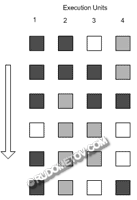The processor with Hyper-Threading
(Continuation)
Evgenie Rudometov, Victor Rudometov.
authors@rudometov.com
Experts of Intel have selected other path. They have carefully analyzed operation of all inner patterns of a kernel of the processor of NetBurst architecture. As a result they have detected, that load on some important sites of the processor is non-uniform. As consequence, during the separate moments some subsystems of a kernel of the processor appear loaded far not on 100 %. Moreover, in some cases idle time of the computer expecting new commands and data is observed. All it is linked to features of performance of tasks. To realise a spare of power of the processor it is possible at the expense of loading by its new tasks. It has thus appeared, that rather small complicating of the architecture of a kernel for this purpose is required, that slightly increases kernel square: approximately on 5 %. But this solution allows to increase considerably productivity of processors without essential complicating of their architecture and the cost price.


Loading of executing units in case of usage of one and two tasks
The given processing technique has been named Hyper-Threading (processing technique HT). This processing technique originally calculated for support in servers and powerful workstations, receives for the first time the incarnation in desktop computers, starting with model of the processor of Pentium 4 with clock rate of 3,06 GHz.
The main sense of processing technique Hyper-Threading consists in support of multistream fulfilment of programs. This processing technique allows to execute simultaneously on one physical processor two jobs or two code snippets of one program. Thus, one processor is perceived by the operating system as two logic units which hard work is carried out in a parallel way. Similar ability of one processor to data processing in a multiprocessor mode met earlier only in servers and workstations.
Productivity of systems with Hyper-Threading, as a rule, considerably exceeds similar parametres of the computers constructed on the basis of processors of the traditional architecture.
The application divided into "streams", is capable to win considerably in respect of productivity thanks to application of processing technique HT. Microsoft Windows XP, for example, concern such applications, Adobe Photoshop, 9 version of Windows Media Encoder and NewTek Lightwave. Processing technique HT also allows to raise productivity of system in the multitask environments by operation with the applications which have been not divided into streams. For example, the user who is carrying out retrieval on the Internet in an operating time of the anti-virus program or engaged in editing of video data during sending of e-mail, will detect the rise of productivity reached at the expense of improvement of possibilities of system to carry out simultaneously two tasks.


Cases when productivity of single-processor solutions with implementation Hyper-Threading raises on 30 % are frequent. And it for a pattern about 3 GHz the processor is equivalent to application of model with frequency of operation of 4 GHz. Experts of the corporation of Intel at the seminars devoted to consideration of processing technique Hyper-Threading, resulted various mixtures of tasks in which productivity growth exceeded 60 % as an example. In case of usage of Pentium of 4 3.06 GHz it corresponds already, at least, to the processor of 5 GHz.
Support of processing technique Hyper-Threading is carried out by multitask operating systems. As such systems it is possible to result, for example, Linux (from the version of a kernel 2.4) and Windows XP. And here popular Windows 95/98/ME for these purposes any more does not approach. As to Windows 2000 Microsoft corporation urgently recommends to use in the computers created on the basis of Pentium 4 with Hyper-Threading, the operating system of Windows XP.
For implementation of possibilities of similar processing techniques of rise of the productivity, realised by means of new processors and chip sets, appropriate motherboards are required.
It can be the cards created on the basis of a number of the newest sets of the system logic — chip sets. As such chip sets chip sets of the corporation of Intel can use:
- Intel 845 PE, carrying out support of memory DDR333 and external graphics adapter AGP for mass and high-powered computers,
- Intel 845 GE, carrying out support of memory DDR333 both external graphics adapter AGP and having the built in graphics subsystem of Intel Extreme Graphics,
- Intel 845 GV, having the built in graphics subsystem of Intel Extreme Graphics and oriented to systems of low cost,
- Intel 850 E, carrying out support of two-channel memory PC1066 RDRAM.
It is necessary to add, that for support of processors of Pentium of 4 3.06 GHz with Hyper-Threading the design of the motherboard and its components should meet the requirements of processors to power supplies and a thermal mode. Besides, it is required corresponding BIOS systems and drivers. Well and, of course, as it already was marked above, the operating systems optimised for usage of processing technique Hyper-Threading.
In summary it is necessary to mark, that by experts of the corporation of Intel release of new model of the processor of Pentium of 4 3.06 GHz there is successfully transited the next boundary of clock rates. In result will reach a new performance level which became still above thanks to implementation in desktop computers of new processing technique Hyper-Threading.
It is published in log "the Computer the Price"
To pass to razrelu Processors English
English Russian
Russian German
German